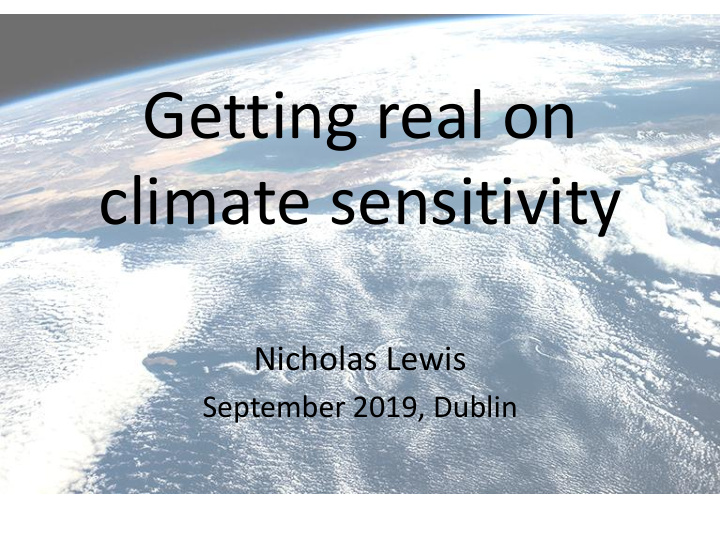



Getting real on climate sensitivity Nicholas Lewis September 2019, Dublin
How I became a climate scientist • Hooked on Climate Audit blog – Steve McIntyre
Why I focus on climate sensitivity • Very valuable to know climate sensitivity accurately • I saw serious statistical errors in published studies
My current views on climate science • Much of the basic science is OK • IPCC : ‘It is extremely likely that human activities caused more than half of the observed increase in GMST from 1951 to 2010.’ [Best estimate ~ 100%] • I remain sceptical of climate model simulations
My publication record • 8 peer reviewed climate sensitivity papers
Engagement with other scientists
Greenhouse effect • GHGs impede radiation emitted by the Earth • Basic radiative physics – not disputable
Greenhouse effect • Big CO 2 trough in radiation to space : grows as level ↑ • Water vapour – key gas but temperature-governed
Is CO 2 absorption saturated? • Effect of CO 2 is logarithmic – same for each 2x
Global climate models • 3D simulation models ( GCMs ) – key in science & policy • GCMs physically-based but use huge approximations
Climate sensitivity • Basic surface warming ~ 1.2 ° C per CO 2 doubling • + / – ‘feedbacks’ increase / reduce basic warming • Main feedbacks: water vapour, clouds, snow/ice • Equilibrium climate sensitivity: metric used to quantify resulting long term warming ECS = resulting long-term warming if 2x CO 2 • Transient climate response: shorter term metric TCR = warming at yr 70 if gradually double CO 2
Long term climate sensitivity - ECS • ECS range unchanged since 1979; mainly GCM-based • IPCC (AR5) ECS 66% range 1.5 – 4.5°C: very uncertain • Typical GCM ECS ~ 3.3°C : 1.2°C basic, 2.1°C feedbacks
Long term sensitivity – Observations Last 150 years observations => ECS 1.7°C (1 – 3°C)
Multidecadal climate sensitivity – TCR • Large ocean heat capacity slows rise towards ECS • Fast warming for 20 years, then slow for 1000+ years • So ECS not a good metric for multidecadal warming Warming in a typical GCM after CO 2 is abruptly quadrupled
Multidecadal climate sensitivity – TCR • Metric used is the Transient climate response • TCR: warming at year 70 if smooth CO 2 rise to 2x • TCR is lower and less uncertain than ECS • < 2100 warming depends more on TCR than ECS • IPCC AR5 TCR range: 1.0 – 2.5°C • GCM TCR range 1.3 – 2.5°C; average 1.8 – 1.9 °C
Multidecadal sensitivity - Observations Last 150 years observations => TCR 1.35°C (1 – 2°C)
Models over-warmed 1979 – 2018
Why do observations & GCMs differ? • GCM- simulated historical warming patterns ≠ actual • GCM ECS low if follow observed warming pattern! • Did natural variability depress historical sensitivity? • Such claims are due to use of a flawed SST dataset
Relating warming to CO 2 emissions • 40% of human CO 2 emissions remain in atmosphere • Airborne CO 2 fraction will fall very slowly, to 15-20% • ESMs project no cooling after emissions cease ESM = GCM with carbon etc. cycle model added • In ESMs, warming cumulative CO 2 emissions • This is why people talk about ‘carbon budgets’ • Carbon budget: cumulative emissions for ⩽ 2°C (say) • ESM-derived carbon budgets are driving policy
Warming relative to emissions in AR5 On RCP6.0 scenario, 3.2°C rise in 2090s; green lines show 1.5°C rise for 625 GtC emissions
Transient climate response to emissions • AR5 ESM-derived carbon budgets ridiculously low • There is a simpler way to project future warming • Use the Transient Climate Response to Emissions • TCRE = warming per 1000 GtC cumulative emissions • TCRE estimated over ~ 70 yrs; ESMs or observations
Projecting future warming using TCRE • TCRE = warming per 1000 GtC cumulative emissions • In ESMs TCRE averages ~ 1.65°C, but ranges widely • AR5 assessed a 0.8 – 2.5°C TCRE range; mainly ESMs • Project future warming as: Future emissions x TCRE + warming from human non-CO 2 emissions etc. • This is what IPCC SR1.5 did – link to ESMs is indirect • But ESMs carbon uptake increase with CO 2 too weak & ESMs carbon uptake decrease as warms too strong • Observational TCRE estimate 1.05°C, range 0.7 – 1.6°C
Warming from observed TCRE, TCR, ECS Warming on RCP6.0 (yellow lines) at AR5 2090s emissions (green line) is 2.0°C vs 3.2°C per IPCC AR5
Methane & Nitrous Oxide • Unlike CO 2 , atmospheric CH 4 & N 2 O are broken down • Exponential decay; Lifetimes (yrs): CH 4 12½; N 2 O 120
Policy implications • IPCC AR5 ESM projections linking warming to cumulative emissions are driving climate policies • IPCC projections => rapid reductions in CO 2 emissions needed to meet ⩽ 2°C (or 1.5°C) target • Observation-based projections => slower CO 2 emission reductions will meet ⩽ 2°C target • Low net emissions needed post-2100 if want ⩽ 2°C • CH 4 & N 2 O emissions matter, but CH 4 decays quite fast
Policy issues • Many climate change policies are wasteful/harmful • Unclear that serious problems if warming 2 – 3°C • AGW a long term problem; adjust policy adaptively • Maybe not the most serious environmental problem
Conclusions • Best observational estimates of climate sensitivity are (for doubled CO 2 concentration): – long term: 1.7°C, 45% below typical GCMs – multidecadal: 1.35°C, 25%+ below typical GCMs • Likely warming to 2100: 60-65% of AR5 projection • Near zero emissions in 2050 not vital: if still high but soon drop, likely warming in 2100 is only ~ 2°C • Warming of 2 – 3°C most unlikely to be disastrous
Thank you for listening Nic Lewis Presentation slides and notes will be available, together with papers and articles by me, at www.nicholaslewis.org
Recommend
More recommend